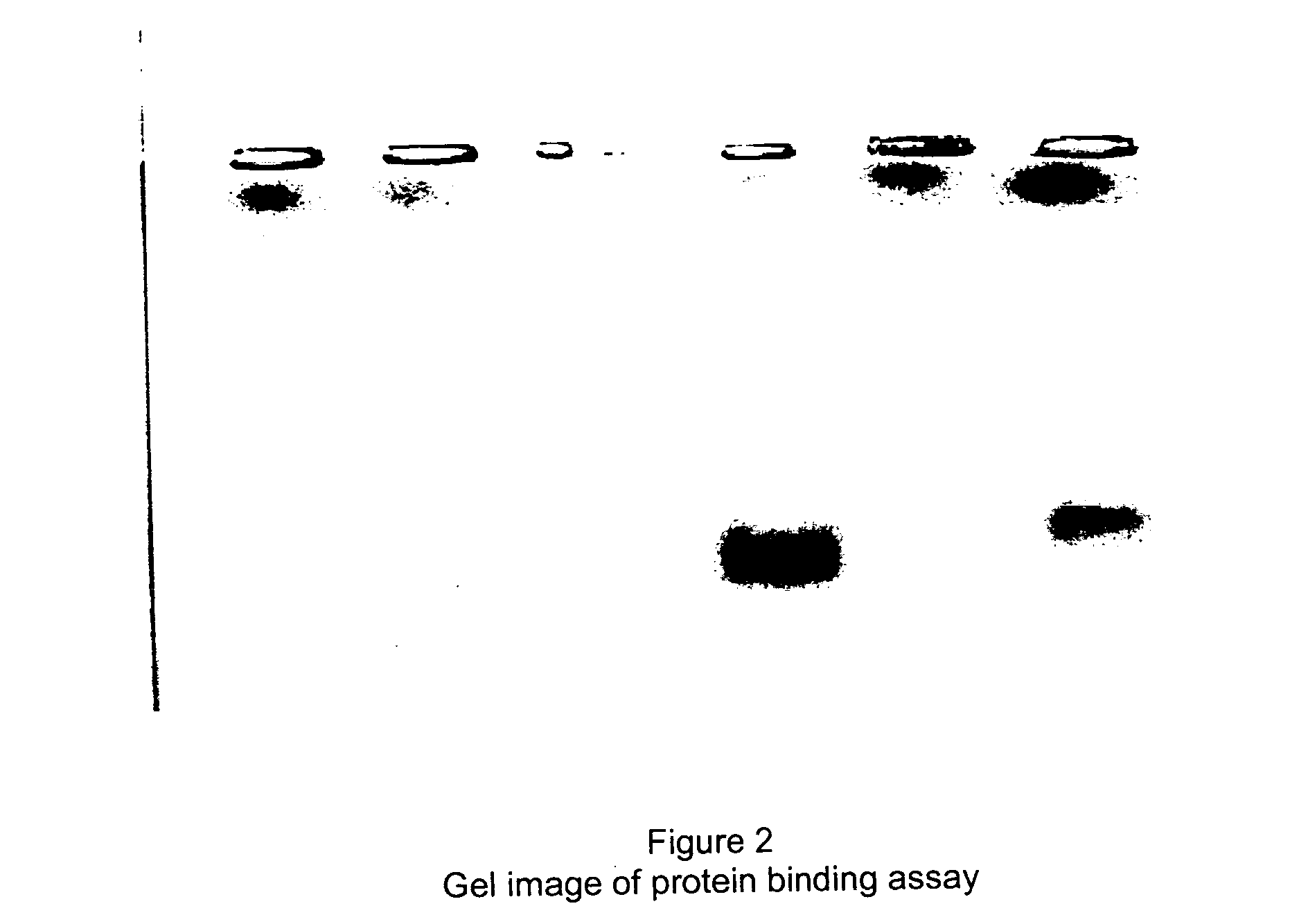Ethylene glycol monolayer protected nanoparticles
a technology of ethylene glycol and monolayer, which is applied in the field of preparation of metal nanoparticles coated with a mixed monolayer, can solve the problems of inability to react easily with biomolecules, inability to bind to alkyl thiol protected nanoparticles, and inability to bind to biomolecules that require aqueous environment for activity
- Summary
- Abstract
- Description
- Claims
- Application Information
AI Technical Summary
Benefits of technology
Problems solved by technology
Method used
Image
Examples
example 1
Synthesis of Diethylene Glycol Thiol (EG2-SH)
1-Bromo-2-(2-methoxyethoxy)ethane (90%, 10.0 g) and urea (99%, 8.3 g) were added into a 250 mL dried round bottom flask. Then 80 mL of ethanol (99.9%) was added into the flask. The mixture was refluxed for 6 hours. After the mixture was cooled down to room temperature, EtOH was removed by rotary evaporation. Then 150 g of 20% NaOH was added and refluxed for 3 hours. The mixture was cooled down to the room temperature and poured to a 500 mL beaker. 15% HCl (prepared from the concentrated HCl) was slowly added into the mixture with stirring until the pH reached 2. The mixture was extracted 4 times with 200 mL of ether. Liquid in ether phase was collected in a 1000 mL beaker and the ether phase was extracted with 200 mL D.I. water to further remove the salt and other impurities. The ether was removed by rotary evaporation and the crude product was distilled at 41-42° C. under 1.2 mm Hg pressure. The final product was colorless with a typic...
example 2
Synthesis of Tetraethylene Glycol Thiol (EG4-SH)
Phosphorous tribromide (9.0 g, 0.033 mole) (PBr3, 99%) was slowly added to a stirred mixture of 10.0 g (0.048 mole) of tetra(ethylene glycol) monomethyl ether (98%, Alfa Aesar, Ward Hill, Mass.) and 2 g of pyridine at 0° C. The resulting mixture was stirred at room temperature for 16 hours. 10 mL of D.I. water was added to the reacted mixture. The mixture was extracted 3 times with 40 mL of carbon tetrachloride. The combined organic extracts were rinsed successively with 25 mL of 10% sodium carbonate aqueous solution, 5% sulfuric acid, and D.I. water. The organic phase was further dried over anhydrous magnesium sulfate and the solvent was removed by rotary evaporation. The crude product was used for the further synthesis of tetraethylene glycol thiol. The procedures were the same as that for the synthesis of diethylene glycol thiol. The yield was ˜20%, due to the fact that EG4-SH is very soluble in water and a lot of product was lost...
example 3
Synthesis of Tiopronin Monolayer-Protected Gold Nanoparticles [Au-(TP)n] with Average Diameter of 3.5 nm
In a typical reaction, 60 mL MeOH (HPLC grade) and 10 mL acetic acid (HPLC grade) were mixed in a 250 mL Erlenmeyer flask by stirring for 2-5 minutes. Then, 0.37 g (1.0 mmol) tetrachloroauric acid (HAuCl4.xH2O) (99.99%) and 16.32 mg (0.1 mmol) N-(2-mercaptopropionyl)glycine (tiopronin, 99%) were added to the above mixed solvents and dissolved by stirring for 5 minutes, which gave a clear and yellow solution. Dissolve 0.6 g (16 mmol) sodium borohydride (NaBH4, 99%) in 30 g Nanopure® water. The NaBH4 solution was drop-wise added into the above solution with rapid stirring. With the first drop of NaBH4 was added, the HAuCl4 solution was immediately turned to dark brown from yellow. It was noticed that this reaction is exothermic. The heat generated in the reaction would make the solution warm for ˜15 min. During the reaction, the pH of the solution changed from 1.2 to ˜5.0. Rapid s...
PUM
| Property | Measurement | Unit |
|---|---|---|
| particle diameter | aaaaa | aaaaa |
| particle diameter | aaaaa | aaaaa |
| particle diameter | aaaaa | aaaaa |
Abstract
Description
Claims
Application Information
 Login to View More
Login to View More - R&D
- Intellectual Property
- Life Sciences
- Materials
- Tech Scout
- Unparalleled Data Quality
- Higher Quality Content
- 60% Fewer Hallucinations
Browse by: Latest US Patents, China's latest patents, Technical Efficacy Thesaurus, Application Domain, Technology Topic, Popular Technical Reports.
© 2025 PatSnap. All rights reserved.Legal|Privacy policy|Modern Slavery Act Transparency Statement|Sitemap|About US| Contact US: help@patsnap.com



